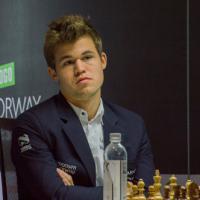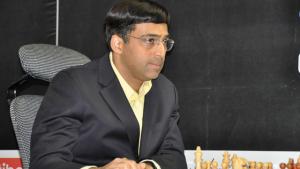
Carlsen vs. Anand | 2013 World Chess Championship
After winning the Mexico City tournament in 2007, Viswanathan Anand had become the world champion.
Anand defended his title for a first time by defeating Vladimir Kramnik in the 2008 match held in Bonn, Germany,
He again defended his title in a tense match with Veselin Topalov in 2010, held in Sofia,Bulgaria. The best-of-12 match was tied after 11 games -- but Topalov, perhaps intent on avoiding a rapid tiebreak with Anand (who was considered stronger at faster time controls), took too many risks in the final game of the match and lost with the white pieces.
In 2012, Anand once more defended his title, this time against Boris Gelfand. Gelfand, one of the top players in the world since the 1980s, was much older than recent world championship contenders; nevertheless, the match was tied 6-6 after the 12 games, and thus decided in a rapid tiebreak, where Anand won by a score of 2.5-1.5.

During these years, however, a player had emerged who took the number one spot in the Elo ratings -- the Norwegian Magnus Carlsen.
It took some time for him to qualify to meet Anand in a match (largely due to his withdrawing from the 2012 qualifying cycle), but eventually Carlsen won the 2013 candidates tournament on tiebreaks over Kramnik, and thus the match with Anand was ordained.
Carlsen was born in Tønsberg, Norway in 1990. A child prodigy, he was the third-youngest grandmaster in history, earning the title at the age of 13 years and five months. Within a few years, he had broken into the elite level, and by the end of 2009 he held the number one spot in the FIDE rating list.
Carlsen has often been compared to Capablanca (or even Mozart...) for the simplicity and purity of his style of play.
In Carlsen's games, you can thus find many examples of great technique. Although he is also a great tactician, Carlsen tends to avoid unclear complications. Nevertheless, he has an amazing ability to set problems for his opponent in even the most simple of positions; we will be seeing this in today's article.
The 2013 match, held in Chennai, India, began with four draws. However, each draw became progressively more "interesting," with Anand getting the better of the third game, and Carlsen being on the verge of victory in the fourth. However, the match was still equal.
We will be examining the fifth game of the match. Carlsen, as white, chose an obscure -- but sound -- opening line, where Anand could certainly get good play in a number of different ways.
However, the line was very unexplored and the number of possibilities was enormous; Anand "found" his way into a minutely worse ending. Carlsen then turned up the pressure, slowly grinding out a win.
Anand, probably shaken by this defeat, lost the very next game as White in a similar fashion. After a couple of draws, Carlsen again won with the black pieces, when Anand -- having conducted a sharp attack which nevertheless was likely to peter out to a draw -- made a terrible blunder, losing immediately.
This basically ended the match. After one more draw, Carlsen became the latest world champion.
* * *
We have come to the end of the "Clash of Champions" series, in which I have examined the endgame play throughout the years in world championship battles.
Although endgame play -- unlike opening theory -- remains relatively stable throughout time, nevertheless it is interesting to see some of the developments and changes in endgame technique.
Over time, experience has clarified positional themes, players grow up with exponentially more examples of good play (Capablanca's games had not yet been played in Steinitz's day, for instance), and the degree of professionalism in top-level chess has increased in general.
What will be in the next "Clash of Champions" articles, which won't be written? (The Carlsen-Anand rematch and beyond?)
Will we see a resurgent Anand taking his title back, or will youth once again win?
Will Carlsen stay at the top of the world of chess, or will he perhaps grow bored and be overtaken by other young players?
RELATED STUDY MATERIAL
- Read the previous article in this series, Clash of Champions: Anand vs. Kramnik.
- Follow coverage of the 2014 world championship at Chess.com/news and Chess.com/TV.
- Watch GM Gregory Kaidanov's video on Magnus Carlsen.
- Play like Carlsen in the Chess Mentor.
- Practice your world-championship-level combinations in the Tactics Trainer.
- Looking for articles with deeper analysis? Try our magazine: The Master's Bulletin.



